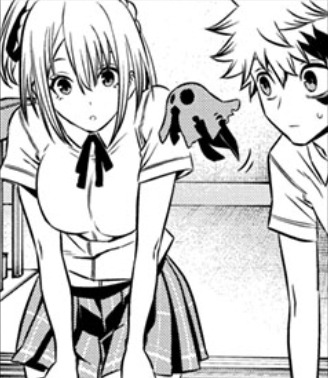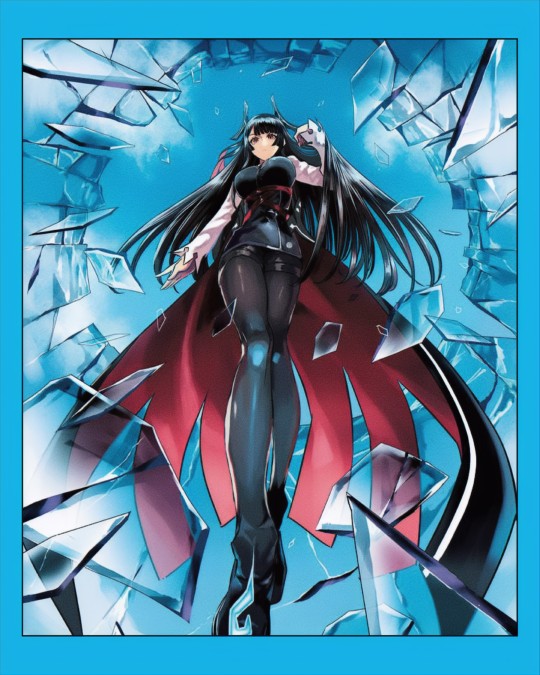#Nue's Exorcist
Text
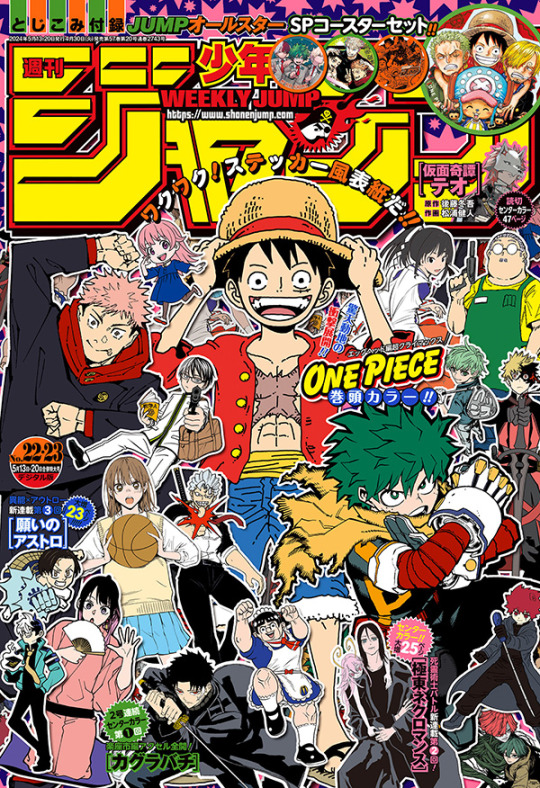
Weekly Shonen Jump 2024 issue #22/23 cover
#Weekly Shonen Jump#One Piece#My Hero Academia#Jujutsu Kaisen#Akane banashi#Sakamoto Days#Undead Unluck#Kagurabachi#Astro Royale#Blue Box#Dear Anemone#Green Green Greens#Kill Blue#Kyokuto Necromance#Me and Roboco#Mission Yozakura Family#Nue's Exorcist#Super Psychic Policeman Chojo#The Elusive Samurai#Witch Watch#manga#magazine cover
48 notes
·
View notes
Text

鵺さん by リブユウキ [Twitter/X]
※Illustration shared with permission from the artist. If you like this artwork please support the artist by visiting the source.
220 notes
·
View notes
Text
HERE ARE THE REST OF THE MANGAKA COMMENTS IN WEEKLY SHONEN JUMP #17.


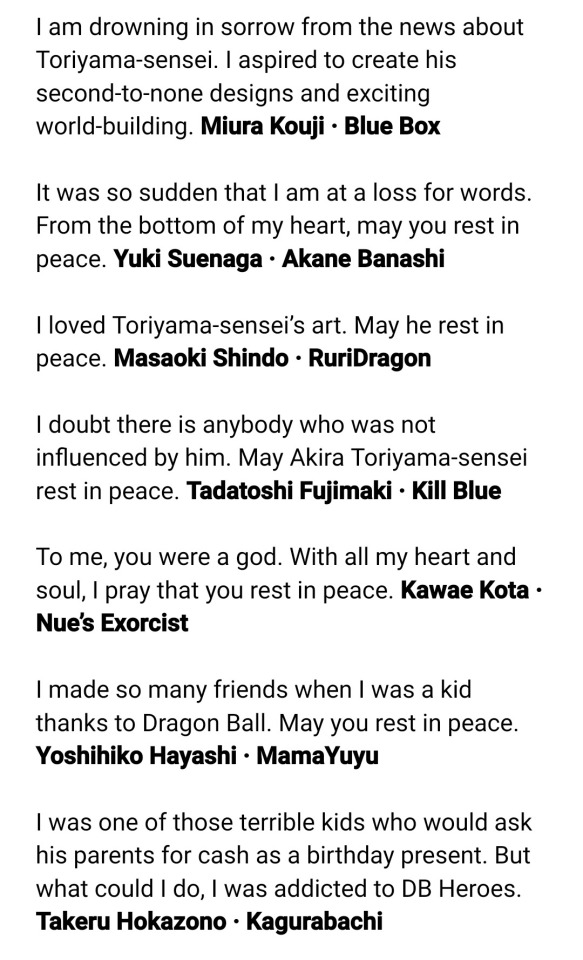

#one piece#jujutsu kaisen#mission: yozakura family#undead unluck#sakamoto days#me and roboco#yusei matsui#witch watch#blue box#akane banashi#ruri dragon#kill blue#nue's exorcist#mamayuyu#kagurabachi#two on ice#green green greens#shadow eliminators#super psychic policeman chojo#dear anemone#wsj#weekly shonen jump commentaries
53 notes
·
View notes
Text
Are We Returning To 2000s Era Shonen Anime/Manga (A Discussion)
So this is going to be way more of a thinkpiece than I usually do for this blog, but recent trends in the space and niche that I devote a lot of time to, Anime/Manga, have been showing themselves that got me thinking. This is not meant to be a serious sociology case study taken as fact, it's going to be more a theory based on observations of the community that I, like many others, devote a lot of time into than a full on claim, but I do want to ask, is the anime and manga community is experiencing a resurgence in 2000s era shonen manga?
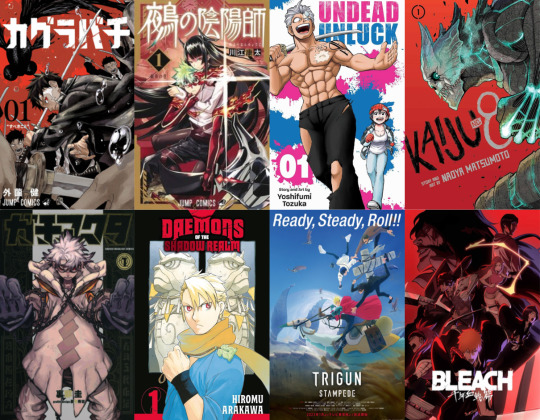
Background
Now let me get this out of the way, there is bias in these observations as I am a western anime fan, but also a North American anime fan. Meaning my gateway and gauges of pop culture are mostly determined by the history of my area of the world’s relationship with anime. From the OVAs of 80s hyper violent and hyper sexual sci fi that you had to purchase from the backs of video rental stores, to the Toonami era of 90s and early 00s programming block the centred around action anime and cartoons, the 4kids era of mass market japanese animated kids shows that were really just giant commercials with some of the earliest memetics in western sphere, and the explosion of shonen battle series in the western sphere in the mid to late 2000s marked by the rise of the colloquially named “Big 3” of shonen jump.
I understand that continents like South America or Europe may have undergone a different exposure to the Japanese medium, but as I am going in with some bias in this observation, I would like to make it clear on where the formula is coming from.
I also would like to lay down a certain clarification before making this, when discussing the topic of nostalgia I think a lot of people have forgotten what it actually means. If we go by the Cambridge dictionary definition, Nostalgia is “a feeling of pleasure and also slight sadness when you think about things that happened in the past.” This is often invoked when talking about pop culture because people from say 20 years ago don’t seem to enjoy or relate to the interests of today. The belief is that nostalgia is generational ergo if you grew up in the 80s you’re likely wishing to recapture the feelings of childhood that you associate with those trends from 20 years ago. In fact, most revaluation in media has often been catalyzed by a difference of those who grew up in an era rebuffing the opinions of those who didn’t.
There is the well known “20 Year Rule” regarding pop culture nostalgia. That every decade it longs for what was popular 20 years ago. Probably no better example than “That 70s show” being popular in the late 90s, the return of many beloved 80s-90s franchises like “Ghostbusters” returning in the 2010s as well as series like “Stranger Things” that wrapped itself up in 80s aesthetics. DC's New 52 relaunch that seemed to bring back trends from 90s era comics.
Now it goes without saying that the 20 year rule isn’t a “real” rule, rather an observation that certain trends make a return to popularity because the ones who grew up with a certain media will be the ones who add to the discourse when they come of age and will be the ones having a chance to create consumable art for the masses and that may just be revivals of once popular IP. This isn’t necessarily wrong in regards to nostalgia, but I do believe that one doesn’t need to have been born in a certain era to be nostalgic for something when we discuss pop culture. Pop culture is really just trends and preferences that become en vogue and people can acquire a taste at any given time. Sometimes it can be due to those who grew up with something now having the chance to create and drawing upon their own childhoods, sometimes it's just due to not being exposed, other times it can be a certain feeling of disillusionment of the now, and seeking something that peaks your interest, and even sometimes it can be major corporations or networks looking for things with existing audiences to draw upon that actually expand the audience. In fact one of the most prominent Netflix adaptations of the 2020s has been live Action Avatar the Last Airbender and One Piece, both shows that got their start on American televisions in 2004 and 2005. One of the biggest animated shows right now is Invincible, based on a comic book from 2003
So I want to stress this is not necessarily about how if you grew up with the original Mobile Suit Gundam show you are being replaced by the kids who were watching GetBackers. And or if you are a fan of shows that came out in the 2000s you yourself were born in the 2000s.
But what was the landscape of the English speaking anime community like back in the 2000s? Well let me paint a portrait for you.
What was the 2000s like for anime fans?
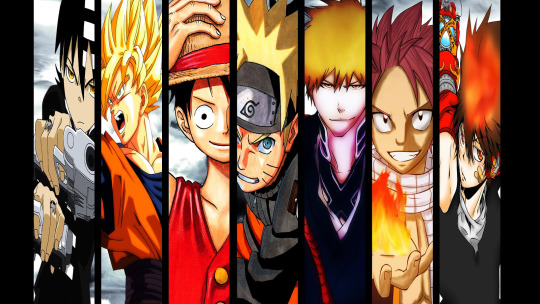
The term I used, “shonen boom period”, is somewhat mythologized in the western anime sphere. There was a glut of high profile shonen anime running around the same time that most people identified with this time period and was arguably when we saw the most influx of people getting into the hobby. One Piece, Naruto, and Bleach served as big series known for their massively large casts, MCs with a level of attitude, some of the most hype centric power supernatural/extraordinary power systems, and certain brand of “Japanese-y” humor.
We can’t deny that it wasn’t just these series however, as series like Fullmetal Alchemist became many people’s introduction to more narratively intricate series interspersed with a somewhat gothic action style. The gothic and somewhat edgy Death Note became many fans' first ever “battle series that’s not a battle series” that also incorporated many biblical and gothic horror elements into its presentation. And things like Code Geass also incorporated this combination of hyper stylized cat and mouse with ornate and gothic aesthetics and fighting robots.
Series like Ouran Highschool Host Club and and Haruhi Suzumiya were basically gateways to the more hyper extraordinary slice of life series that didn’t shy away from fanservice and loud comedy. With ecchi like Rosario + Vampire taking it to an even greater extreme. For people willing to go even deeper, series like Fairy Tail began to pop up and share a distinct similar flavor to series like One Piece and Naruto which arguably started the popular conception of it coming from the same magazine as the latter. That’s not also discounting the amount of holdovers from the 90s like Dragon Ball z, Trigun, and Yu Yu Hakusho, which also had an edge towards fantastical combat and comedic oriented series.
All of this is to generally illustrate the media diet of what an average anime fan was expected to have some level of access to. As this was far before the eras of Funimation or Hulu having online services. Not a homogenized spread by any means, and im certain plenty of readers could name more underground or smaller series like Mushishi or Elphen Lied, but generally the popular mainstream you could tell that there was a consistent theme of long form media with a very loud, very flashy, and very action oriented type of series. Which I think is fair to say had skewed some people’s perception. And while I cannot claim with utter certainty that Japan was the same in this regard, you can look at magazines like Shonen Jump and notice a somewhat synchronistic trend. With series like Hitman Reborn, Gintama, D. Gray Man, Eyeshield 21, Bobobobo, etc.making a clear marcation of what was commercially successful at the time.
Even series not inside the magazine but had smaller nicher, Tokyo-pop-esque series like Rave Master, Flame of Recca, Air Gear, History’s Strongest Disciple Kenichi, Soul Eater, etc all had a similarity to the shonen jump magazine. To the point it was not uncommon to see so many jump characters in a collage and one from shonen sunday or shonen magazine in there as if this was all coming from the same place.

Changing Landscape
Now with the advantages of the modern internet, we have the ability to actually keep up with the jump magazine in real time as opposed to the common practice of relying on scanlation site and fansubs that were often devoted to the most popular works. But with simultaneous publication and services like Crunchyroll, being able to access a wider variety of shows and series that we may or may not have access to. I believe that the 2010s in the english speaking fanbase was the decade we saw a somewhat expansionism of what people perceived as anime. Anime could be One Piece and Naruto, but it could also be Erased, it could be the Promised Neverland, Attack on Titan, K-On, Haikuu, and Durarara. With the representatives of the 90s no longer being holdovers in syndication like dragon ball but rather full on revivals of the likes of Jojo’s Bizarre Adventure and Hunter x Hunter.

All of these could be "shonen" but also other genres like Seinin, Josei, and Shojo all had their own varying layers of what they could be in their demographic
The mood of what was popular was also changing, not just in the fact that more flavors of anime and manga were becoming mainstream, but new works from shonen jump showed a rise in almost subversive series like My Hero Academia and Demon Slayer that seemed to consciously deviate or place new spins from traditional tropes of the 2000s characters, and we saw works that were derivative of previous serious like Black Clover drawing upon Naruto the same way it was known that Naruto had drawn upon Dragon Ball before them. Series like The Promised Neverland and Doctor Stone offered up more dramatic series that still infused a certain energy of the shonen genre.
And of course the series like Attack Titan whose much more darker and gorey storytelling seemed to have become one of if not the biggest hit of the generation with a well regarded adaptation, but something that had felt so removed from what were once contemporaries like the then ending Bleach or Naruto. We can also note that the late 2010s saw the rise of series like Chainsaw Man and Jujutsu Kaisen that began a trend of popular urban fantasy stories. Where fantastical concepts were now in contemporary Japan and the stories that focused on concepts like self identity and the harshness of maturing were juxtaposed to the real world inhabited by monsters.
It seemed many tropes of the previous decade were still alive in the rise of Isekai anime. Which was particularly the only popular outlet for fantasy stories with an action orientation. But these almost felt disconnected from the wider world of manga as things like heavy harem action series had actually decreased in mags like shonen jump. There was also new tropes being established in this subgenre that became unique popularizations of tropes all on their own, such as the overpowered protagonist whose power everyone believes is weak. But many of these were based on light novels, a form of media that only in the last few years western readers are having official access to and not simply scans found on the internet.
We in North America truly have gone from anime being a niche that was primarily accessible through dedicated TV blocks like Toonami, to a full blown cultural relevance shift.
We also need to talk about this era in its perception of the past also shifted. The 90s and the early 00s often blend together as classics of the anime community. Somewhat encased in amber. However, there is no denying that “feels like a 2000s series” had become a bit of a shorthand for very goofy, Very horny, very action heavy series. Series like Fire Force and and Undead Unluck had their show what more problematic elements be equated to the problematic trends of the past that people just accepted as “a part of the medium.” But lets keep in mind, this is not really describing a time, more a trend. Superficial elements that invoke similar feelings of the past.
Speaking of anime fans…
Fan Culture
So while I wanted to paint a picture of creatively the landscape has changed, there’s no denying that in the age of internet accessibility, the anime fan community has also changed. It is much much easier now to get in contact with people who are anime fans now than it was to rely on word of mouth like it was back in the day. I can still distinctly remember my anime club which wasn’t even really a club devoted to anime but rather other geek stuff like D&D and TCGs. Our hobbies just happened to have similar overlap.
Now though, anime fan culture is much more relevant and thriving. Going from just posting weekly reviews, to long retrospectives, comedy videos, abridged series, clickbait articles, fan theories, and podcasts. However, I think a defining feature of fans of the 2000s era of anime that were at their most prominent was hype culture.
Due to many of the biggest anime series at the time being released weekly and focusing on action, many many many discussion boards and videos were often about staying in this cycle of wanting to see what happens next and the action made people very excited to see just how characters were going to win fights or even if they’d have fights at all.
I want to make it clear that this type of activity doesn’t belong to a certain era, but you can see it shaped by the 2000s era. Especially when discussing “what is the next big 3.” As if it were a true position and title, rather than a moment in time where there were just three very distinct shonen series in the fanbase.This doesn’t necessarily have a “negative” effect on the discussion of anime/manga but you can see that certain genres lend themselves to hyping fans up more and more.
Someone isn’t reading the most recent chapter of a romance like Blue Box with the same level of anticipation of who will face who like it was One Piece. But there have certainly been series that try.
The Present
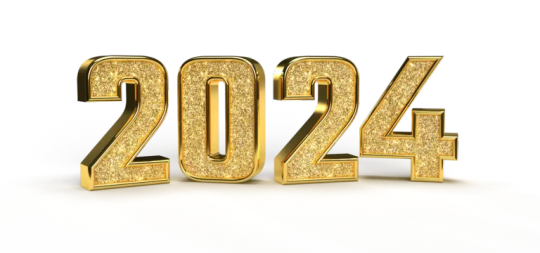
Now we reach the 2020s and this decade is still young, so it is hard to say what the future will hold for certainty, but we can look at the last four years and notice some significant waves being made recently in Shonen Jump alone. I already spoke of Undead Unluck, a series that almost wears it would now be considered retro inspirations on its sleeve. With an opening chapter that establishes an MC that seems motivated by a sexual joke, A power system follows a verbal naming gimmick, and a loose enough world that allows for characters of varying aesthetics and to be incorporated into groups. With groups of these powerful characters splitting up to face each other and use their ridiculous power to the extreme. Even in the series' own meta arc about creating manga, the in-universe analogy for Undead Unluck’s manga is commented on as feeling retro.
There is no doubt the biggest viral hit of the decade so far has gone to Kagurabachi, a manga about sword fighting and magical crime lords that seems almost indulgent in its stylistic slicing and or dicing of baddies. Its memetic success was primarily due to a somewhat sincere and somewhat ironic belief that it would be the “next big thing” as it promised to be a stylized action series. Another surprise viral success has been the manga Nue’s Exorcist which sees another supernatural swordfighter boy harness the powers of his sexy spirit lady while getting into harem shenanigans that echo a particular form of ecchi of anime’s past that had actually been somewhat absent in the past decade in jump. Both of these series have a somewhat noticeable similarities to Bleach, a long running shonen action series that has seen its own revival in the last few years of writing this with the long awaited adaptation of the final arc of the bleach anime.
While the other members of the “big 3” never truly went away and became almost inter-generational, Bleach truly did feel like a “come back” as it was absent for so long. And unlike Hunter x Hunter and Jojo which were never really popular in the west and even their older anime are more regarded as anime deep lore. Bleach was one of the most popular series in the west at the time to never receive a conclusion animated.
Speaking of anime of the 2000s Trigun Stampede was a reimagining of the original late 90s show. This errs a bit similar to Hunter x Hunter’s style of revival, but also seems uniquely its own in actually trying to find a balance between the original series but adding in things cut from its original late 90s early 2000s counterpart.
And now we must examine other shonen magazines. Series like Gachiakuta created by a former assistant of Okubo, the creator of Soul Eater, carries with it much of the similar energies of that series. Its also noticeable as being a truly dark fantasy series. Not an urban fantasy, but rather a completely new world that had a very grunge and dirty world building. And then there is Daemons of the Shadow Realm, a series by Fullmetal Alchemist creator Hiromu Arakawa. This series is also set in modern day japan with supernatural elements, however Arakawa’s style of writing is practically unchanged from her time on FMA. With an emphasis on action, intricate mysteries, and character building comedy with her trademark over exaggerated blocky style. There is of course Hiro Mashima who has started another new series, Dead Rock, and his style has also not changed that much. Then there is just flat out sequels to 2000s series like Gamaran Shura.
This to me shows that we are seeing a bit of a combination of people who are now entering the workforce inspired by creators of the past, but also that creators of the past still exist 20 years later and are still making content that hasn’t really undergone significant change.
Of course, we can’t also forget the implementation of the Manga Plus/J plus service which has opened up a very interesting ground for creators to have some of the most creatively out there series than what you may have expected from the shonen jump brand. I genuinely don’t think series like Make the Exorcist Fall in Love or Fire Punch would’ve ever been acceptable in the pages of a weekly shonen series. However one series in particular does feel like it could've and boy its been quite the success. Kaiju no 8.
Kaiju no 8 almost feels as though it is the AoT of a new generation with the amount of anticipation this one series has as well as the similarities between the series superficial elements. However, I'd say the key distinction between the two has been the tone. AoT took a dark and practically dour tone on its titan infested world. With an MC declaring war on all of his enemies. The pain was realistic, with human bodies being brittle and vulnerable. And the belief that just because you were a good person you weren't going to make it out alive. Kaiju no 8 instead opts for a more action oriented tone. Down playing the bleak realism for more "Hell yeah!" moments. With super science weapons that feel more akin to a tokusatsu show and fights and battles between humans an kanji the feel like the Dragon Ball style wrestling matches of old.
And of course, that’s not to say Jump hasn’t continued with series that feel more modern like the realistic and mellow romance of Blue Box or the dramatic coming of age story of Akane-Banashi.
But the presence of these series has caused somewhat of a friction with the popular conception of the magazine. Its safe to say that while “shonen” tends to think of action male oriented series, it can really just mean works aimed more at adolescents. But I think many tend to associate this familiar feeling of “what is shonen” with their popular introduction of the magazine. With a saturation of action and brash comedy series. This is further complicated by the fact many action series in jump are actually ending over the last decade. With new ones not popping up to replace them as frequently and series like One Piece and MHA and Black Clover basically stretching out across an entire decade or longer.
In fact, I don’t think it's unreasonable to believe that the hype for something like Kagurabachi was in part a belief that it signaled a return of a type of familiar series and genre that had been missing. Or at the very least, looked to fill an inevitable gap the magazine was obviously going to be facing. Followed by the other commercial success of Nue’s Exorcist, we are likely to see these series last for a long time. At the time of this writing, Tokyo Revenger’s author Ken Wakui has released Astro Royale, a series that feels very similar to his previous work yet infused with this almost GetBackers flavor.
So that leaves us with the question at the start, are we seeing a rise in 2000s nostalgia in anime and manga?
Conclusion
So I'm sorry if I disappoint, but the best I can say is, I’m not certain. I do believe that from my observation I think it is reasonable to say that we are seeing a rise in creators in the shonen space being ones inspired by series from 20 years ago. However, I think we are also seeing creators who are from that time period also returning to write how they have always written.
On the consumer side, I think we can see that fans of anime and manga have changed in the sense their tastes can now be shaped by a much larger catalog of series at their disposal. But in the case of shonen, I think we are simply seeing those who likely got their start in anime at around the 2000s resonating with newer series drawing upon those series, but also with younger fans now likely to grow up with the tail end of what was popular in the 2010s now being influenced by the 2020s.
I also believe that one of the defining features of the anime community in the last decade is hype culture. And currently we are seeing a rise in series that actually feel more catered to hype, be it a revival of a series they liked or predicting what will be the next success.
All and all, this piece was trying to tunnel on the shonen demographic in general, which is more likely than not going to have similar traits relative to itself. I do see us as a community endorsing trends of the past and there’s an excitement for these things to “come back” even if they may or may not have left.
If you liked this please drop a like or reblog because I may do more of these think pieces in the future.
#anime#manga#think piece#discussion#shonen#shonen jump#kagurabachi#gachiakuta#nue's exorcist#undead unluck#kaiju no. 8#bleach#one piece#naruto#yomi no tsugai#attack on titan
44 notes
·
View notes
Text
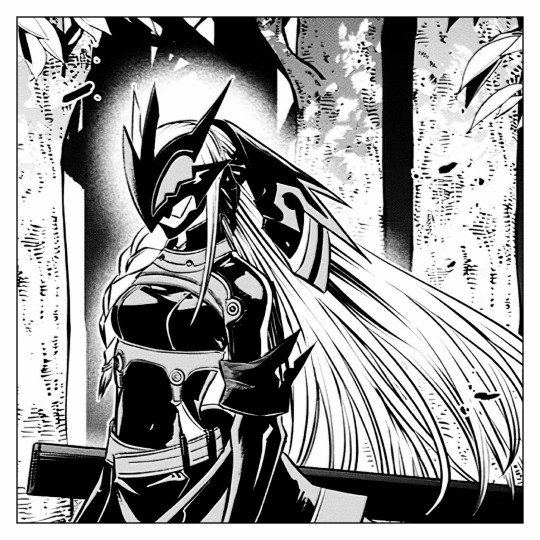
7 notes
·
View notes
Text
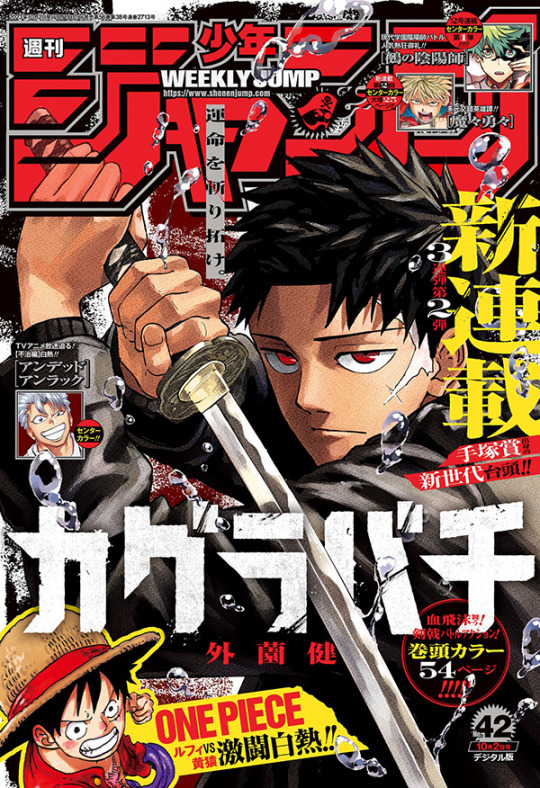
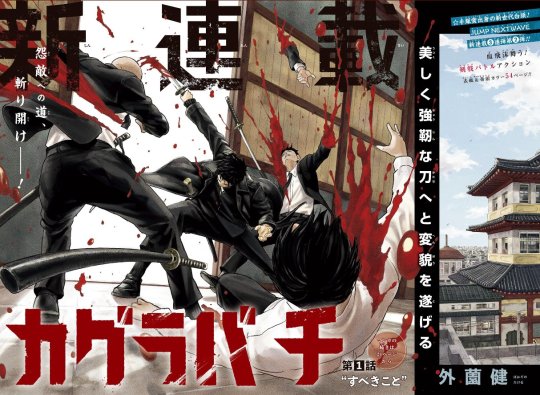



Weekly Shonen Jump Issue #42 Cover and Color Pages!
#manga#anime#anime and manga#shonen jump#weekly shonen jump#kagurabachi#mamayuyu#nue's exorcist#undead unluck
18 notes
·
View notes
Text
Blue Exorcist saison 3
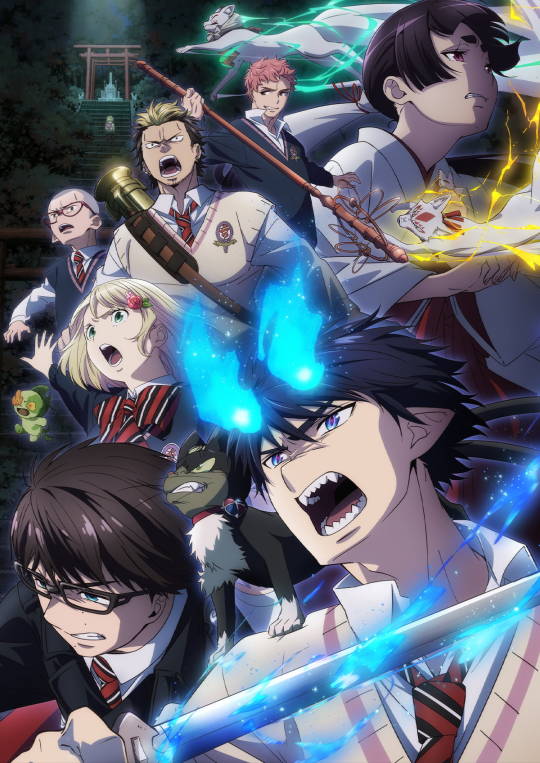
Bonjour et bonsoir à tous, je viens pour vous annoncer que des images officielles du très attendu retour de Blue Exorcist sont sorties: Suivez le lien 【图片】「青之驱魔师」动画第3季PV 24年1月放送【蓝色的除魔师吧】_百度贴吧 (baidu.com)
Sa sortie est prévu pour le 24 janvier prochain, alors soyons tous au rendez-vous et espérons que Kaze ou Crunchyroll soit également au rendez-vous pour une vf^^
#blue#exorcist#ao no exorcist#nue's exorcist#blue exorcist#rin#yukio#rin okumura#yukio okumura#anime and manga#anime#manga#saison 3#season 3
9 notes
·
View notes
Text
at this point, i'm cheering for Nue's Exorcist to keep going, not because i think it's a good series, but instead because i want it to get an anime so more people will draw fanart of the girls
2 notes
·
View notes
Text
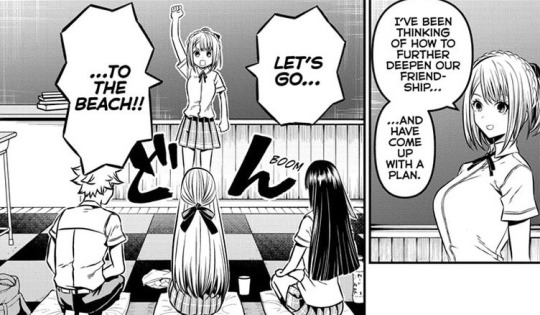

7 notes
·
View notes
Text
Shonen Jump Manga Round-Up(May 30th, 2023)

Another week and more chapters! The format is still a work in progress so I’m still figuring things out. There’s a semi-leftovers section at the end but after the cut we get into the meatier discussions. See ya down there!
The Ichinose Family's Deadly Sins(Chapter 26)
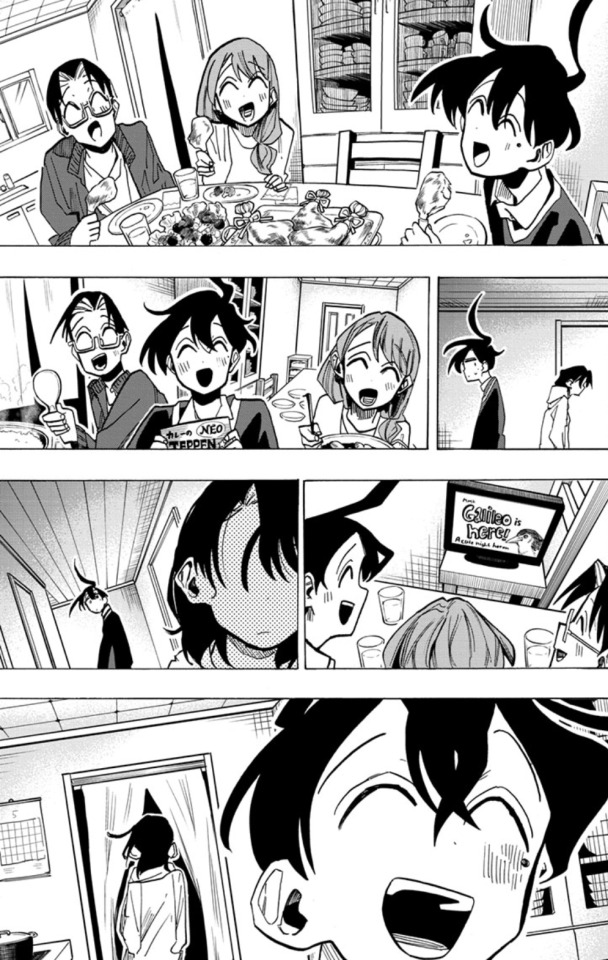

This was such a great chapter. It told a really solid story and had an arc that it completed all in one chapter instead of spinning its wheels like the series had been for the past little while. And for me, it helped to bridge an understanding of some of the themes it’s going for. I had been curious about the other family members now that Tsubasa is awake. And seeing Shiori sends a chilling message. Her parents have completely given up on her. This is another chance at life for Tsubasa so he’s doubly motivated but he was just like them before. They had all retreated within themselves because no one was trying to fix things. His parents worked with each other to fix things because their arms were reaching for help. They needed the encouragement of someone asking for help to help them out. And it’s valid that you can’t help someone unless they’re willing to help themselves out but Shiori is their child and they haven’t even tried to see her cries for help. And I think this blase attitude is meant to rub us wrong because despite their cheery disposition, their parents are still broken people. And at least right now the message I’m seeing from this series is that broken people can’t save other broken people. But! They can help each other heal. As we see in the panel above, where silently the siblings find comfort in each other’s company. Tsubasa acts optimistic because he has to. But he’s just as broken as the rest of them. And it’s also in this and the title that we find another major theme of the story. Separate, the family is fragmented, disjointed, and broken. Shells of their former selves because they pushed away the ones they love the most. But slowly, as Tsubasa brings them all close to each other, and they reach out to one another, they find themselves healing. As the chapter ends we get another hint that all is not right as Tsubasa is able to remember someone he only learnt about in his dreams. I hope he’s actually woken up and it’s not one of those IT WAS ALL A DREAM type of things. The twist the first time around was great but it could get repetitive and retread old ground if it happened again. Though if it does, I have faith that it’ll lead somewhere.
Akane-Banashi(Chapter 63)

This series has an incredible skill in telling the stories of side characters. And in an incredibly meta way, this method of storytelling goes back to the purpose of Rakugo in not only entertaining but telling these little slices of life of different people. Seeing how Akane called Rakugo a time machine, this series itself snips out moments of character from it’s supporting cast. And sure that method of character development is common, with the audience learning of character’s backstories as they appear more, but what Akane-Banashi does is just like how Rakugo emphasizes behavior, little quirks of character and moments of self expression, so does the story itself. Whereas a character might make some plot related decisions before their motivations are revealed, characters in this show behave in incredibly unique ways and that little snippet in time that we see of them justifies that behavior. Take Kaichi for example. While him being boisterous in this chapter was a conscious decision, it’s also just a part of his essence, just like how the mannerisms a Rakugoka imbues their character’s with is a part of their essence. Drunk, miserly, naive. All characteristics, just like Kaichi’s people-pleasing. And just as the story stories justify their behaviors and vice versa, so does the little looks into character’s pasts we get. I love these little stories and I especially love the character of Kaichi. He’s such an interesting and unique character. He started off seeming like someone doing Rakugo on a whim because of a mid-life crisis or some such thing but he’s quickly evolved into a very complex character despite having such a simple motivation. This also shows how motivation and backstory aren’t the only factors in making character’s complex, as his open defiance of the old school judge is what really contributes to his emergence as a three dimensional figure.
Tenmaku Cinema(Chapter 7)

Tenmaku Cinema continues its streak of being incredibly relatable by accurately relaying the feeling of shooting a short film. Especially a high school one. But before we get to the high school aspect of it, I want to talk about the above panel, where Tenmaku mentions the tension and euphoria of a shoot. The thrill of directing is like no other, and not having done any since the pandemic, I miss it dearly and have gained a lot of perspective on it. I think the best representation of it is in 8 ½ by Federico Fellini in which Marcello Mastroianni’s Guido balances the chaos of his personal life with the chaos of directing. While directing may be more chaotic and destructive, it’s a chaos that he thrived in. I felt the same too. I wonder what it is about it that makes so much sense despite being so chaotic. Perhaps it’s the finding of order within the chaos that’s the real beauty of the art. Moving on though, the idea of shooting that much coverage makes me wonder if we’ll see Hajime drop that going forward as he becomes more confident. He’s choosing a particular type of shot, while having additional hands shoot coverage. Coverage is good if you can get it, and the advantage of shooting on phones is that you’ll have enough cameras for it, but coverage can make people lazy in what should be a purposeful art. And I guess the manga won’t cover the nitty gritty of gear as different phone resolutions and picture quality could make a dissonant scene. But I think that’s for the better, as Hajime’s journey is to be a filmmaker and he needs to trust his crew. And speaking of crew, he’s got a dream team with him! I love the supporting casts' different strengths and look forward to learning about them. And them entering the film into a film competition also reminds me of Keep Your Hands Off Eiuzouken! which I read and is an amazing experience in manga form. The enthusiasm in that was more vibrant where here it’s slightly more muted in favour of Hajime, Hemeki, and Tenmaku’s characters and relationships. I love how the high school setting of this short film shows the duties of directing amateur productions other than the blocking and shot selection. The having to wait for people to leave and working around other’s schedules is an integral part of those duties. I’m really digging how Tenmaku Cinema picks and chooses aspects of filmmaking while ignoring others to make a picture that accurately reflects the feeling of shooting. It shows the authour’s mastery.
Undead Unluck(Chapter 160)

This chapter shows off Undead Unluck’s heart in such a great way. Undead Unluck has many great qualities, but to me, its heart and optimism is what shines forward the brightest. I don’t know if it’s just me but the Phil stopping the shuttle reminded me so much of Superman and in a roundabout way, the Iron Giant. Phil is ostensibly a weapon now, a living and unfeeling artifact. But Fuuko, Gina, and Nico help him realise that he doesn’t have to be a self sacrificing tool for other people. I wonder what the twist of Unfeel in this loop will be as it seems to be incredibly detrimental. I wonder if it’s something that helps him ignore fear and consequences about himself. In that case it shows why Union is so beneficial to him as they can protect him like how Gina did. They’re his friends and Nico even feels like a surrogate father to him as he calls him my boy at a certain point. In this way, if he can still feel emotions like love and happiness and just ignore certain ones, it strengthens the point of Union as they can support him in a way that allows him to be reckless. I recently started reading Omniscient Reader’s Viewpoint and it helped me understand how Fuuko’s Union is different from Juiz’s. Fukko’s is kinder and where Juiz might have left people or their lives behind as acceptable sacrifices towards a better outcome, Fuuko refuses to do so. And this whole concept of looping also shows how important the one life you get is. Fuuko’s hellbent on making sure everyone gets the most out of this one life they have whereas Juiz was okay with the people suffering if it meant it was a more optimal build. In a funny way it reminds me of how in competitive games there’s a stark difference in playing the way you want versus the way that’s optimal. Fuuko definitely listens to the heart of the cards.
Maybe Some Left Over?
The only thing I have to say about the manga I’ve dropped discussing is Wowee! The fight going on right now in Jujutsu Kaisen(Chapter 224) is so fun!
Moving on to manga I’m still discussing but didn’t have that many interesting thoughts on, The Elusive Samurai(Chapter 111) moves away from Tokiyuki for this chapter and focuses on Takauji. It’s building up his legend. It’s an effective technique at setting the stakes as it was revealed in the horrific showdown between Tokiyuki and Takauji how Takauji actually works. And after such an impactful reveal, he’s now allowed to be as ruthless as he has the potential to be without the main character in harm’s way. I love learning about history and knowing that this manga is very lightly based on history I am having to hold myself back from searching up how the battle chowed at the end of this chapter went as it looks as impossible as the battle Battle of Thermopylae.
Me & Roboco(Chapter 138) takes us back to Roboco’s Idol days and leaves us with one of the funniest and stupidest final panel’s in its history. Roboco’s compulsive need to be liked is such a good motivator for gags.
Fabricant 100(Chapter 23) brings the story back to themes of self-sacrifice, as 100 quite literally sacrifices part of herself to ensure her and Ashibe’s survival. And bringing it back to this idea of completeness, of healing, while this fire is an innate part of 100’s physiology, it furthers something that’s been itching at the back of my mind. And that was what the correlation between the themes of self-sacrifice and completeness are? And I believe the culmination of the two messages is the idea that chasing perfection, of trying to complete oneself through improvement or a need for some sort of fulfillment like revenge is destructive, quite often self destructive. It’s an impossible pursuit. And for being a battle shounen that’s quite a zen statement. So much so it reminds me of an old favourite in Shaman King. Another thing I noticed was the chapter’s title, Prometheus Flame. Not only does it conjure up imagery of the Greek Titan but also Frankenstein’s original title, The Modern Day Prometheus. In all three, the gift given, be it life or fire, is both a blessing and a curse.
Cipher Academy(Chapter 25) gives us a better look at Iroha’s upcoming opponents and hints at Toshusai’s backstory. Two things I loved about this chapter were how it showed off how clever and characterized the dialogue was and how Iroha has adapted the characteristics of his opponent into himself, such as Yosaimura’s camaraderie and Ano’s unhinged lies. You can see how characterized everyone’s dialogue is through their little affectations and this idea of collaboration and growth through working together as well as the idea of character affectations is shown wonderfully through Toshusai stealing Kogoe’s catchphrase of “Can’t say that too loudly, though…” right at the beginning of the chapter. One last note is how Kogoe’s catchphrase encourages hiding the truth while Iroha’s encourages open communication and demonstration.
This week’s Witch Watch(Chapter 110) had me howling with laughter. While Kanshi can be mischievous, Miharu is such a devious little shit-stirrer. I’m so glad Fran has been as prominent as she has been because the gags with her are the best. Jekyll’s transformation requirements are going to stay with me for a while.
Kill Blue(Chapter 6) pulls such a great move that I see why they ended the last chapter the way they did. Series like these, where character’s get reverted in age often have to tiptoe around the line of age-appropriate romance. Kill Blue set this up as early as it could so that it could firmly establish that it wasn’t going to fall into that trap. Also as a way to establish the fact that there’s a way to get Ogami closer to Noren as we saw at the end of the chapter there but it was mainly to reiterate the heart of the series. I really appreciate how quick Ogami was to shut down even the suggestion. Just as Ogami is normalized by Ryo, his sister and Noren, Ogami does the same for Noren. It’s tiptoeing a dangerous line once again but after this chapter I have faith in the storytelling.
Blue Box(Chapter 102) starts off with a hilarious character poll where Taiki has been absolutely crushed by Chinatsu and Hina and goes on to show an incredibly tender chapter where even in the vast and empty landscapes, our two protagonists think of one another. And in a twist of fate are brought together. It would be incredibly romantic if they do meet and confess to each other within the time they’re here so I’m eagerly waiting to see how this plays out.
This chapter of Do Retry(Chapter 4) made me realise what kind of manga Do Retry is and I think I’ll hang with it. Because alongside the exaggerated characters and the hyper violence is also a world that blends realism with grounded fantasy. The twisted world of Do Retry reminds me of a Jump oneshot from around 2018 or so I want to go back and see if it’s the same authour before the next chapter. I think the harsh nature of it also shows how the war twisted Japanese society in a really effective way. It wouldn’t make sense if the point of view was gentle.
Nue’s Exorcist(Chapter 3) makes me feel like it’s starting to head towards plot and abandon the loose fights. It’s weird, and I think it’s for very few people, but I really like this unfocused and unspecific atmosphere this manga has. It doesn’t explain everything but it feels like there’s an order to things we’ll slowly uncover. While it does leave a lot of room for potential, I love how it uses this vibe to strengthen characters. Gakuro Yajima is super milquetoast, but from the get Zenno has been a unique and strong presence and in this chapter, he’s joined by Kazusa. In this we also get the experience first and understand later as we find out about her as a character before we learn her name or her occupation as an exorcist. It’s getting interesting.
In what might be my favorite chapter of the series, Sakamoto Days(Chapter 120) brings this journey into the past to a close. I can’t recall if Kei was confirmed to be Slur, but it’s no surprise he is as this flashback was mostly centered around him. After a stunning set of silent scenes where in the middle the background drops away in the heat of the fight, before picking up as Sakamoto gains the advantage. The fight scene carries weight. It’s emotional and different from the comedy of an older Sakamoto. I honestly hope Sakamoto Days pivots from it’s looser comedy filled story into this darker story it’s dipped it’s toes in because it really works. I don’t know if they will as this was only a brief journey into the past but one can hope.
#the ichinose family's deadly sins#akane banashi#tenmaku cinema#undead unluck#the elusive samurai#fabricant 100#cipher academy#witch watch#kill blue#blue box#do retry#nue's exorcist#sakamoto days#manga recap#manga discussion#manga#weekly shonen jump
8 notes
·
View notes
Text

Weekly Shonen Jump 2023 issue #36/37 cover
#Weekly Shonen Jump#One Piece#My Hero Academia#Jujutsu Kaisen#Akane banashi#Black Clover#Sakamoto Days#Mission Yozakura Family#The Elusive Samurai#Witch Watch#Blue Box#Me and Roboco#Undead Unluck#The Ichinose Family's Deadly Sins#Cipher Academy#Fabricant 100#Tenmaku Cinema#Kill Blue#Do Retry#Nue's Exorcist#Martial Master Asumi#Ice Head Gill#manga#magazine cover
362 notes
·
View notes
Text
SHONEN JUMP FIRST IMPRESSIONS DIGEST PT. 2
I guess this batch got split up by Golden Week. You'd think they could plan that out a bit better but what do I know. anyway.
Do Retry: Stop me if you've heard this one before. It's a shonen manga about a young boy whose primary character traits are loyalty and pertinacity. Really boundary-breaking, I know. The only almost-interesting thing about it is that it takes place in the aftermath of World War II, but the series doesn't do anything interesting with it (at least, not in the first chapter). It's just another way to make Hero Kidguy (or whatever his name is)'s life more shitty so you'll find his determination more inspiring. If you're really hurting for a new boxing manga I guess you could do worse but there's not really anything to recommend about it. Just skip manga entirely and watch Megalobox (or read Ashita no Joe, I guess).
Nue's Exorcist: They have cancelled so many series with this same basic premise that one must wonder why they keep trying it. Just because Bleach worked for a bit doesn't mean you can keep copying it ad nauseam. Anyway this shit is lame and just makes me mad that Tokyo Demon Bride got cancelled, and all that series really had going for it was Keroru.
2 notes
·
View notes


